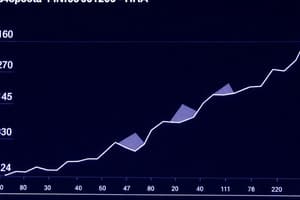Podcast
Questions and Answers
Population refers to the total number of people living in a specific geographic area, such as a city, town, or country.
Population refers to the total number of people living in a specific geographic area, such as a city, town, or country.
True (A)
Census data is typically collected every 5 years.
Census data is typically collected every 5 years.
False (B)
The United Nations provides estimates and projections of population growth.
The United Nations provides estimates and projections of population growth.
True (A)
Population growth occurs when the number of deaths exceeds the number of births.
Population growth occurs when the number of deaths exceeds the number of births.
Migration is a factor that influences population growth or decline.
Migration is a factor that influences population growth or decline.
A population pyramid is a graphical representation of population structure, with age on the y-axis and population size on the x-axis.
A population pyramid is a graphical representation of population structure, with age on the y-axis and population size on the x-axis.
An expanding population pyramid has a narrow base and a wide top.
An expanding population pyramid has a narrow base and a wide top.
The demographic transition model describes the shift from low birth and death rates to high birth and death rates in a population.
The demographic transition model describes the shift from low birth and death rates to high birth and death rates in a population.
The demographic transition model consists of five stages.
The demographic transition model consists of five stages.
In stage 1 of the demographic transition model, death rates decrease and population growth increases.
In stage 1 of the demographic transition model, death rates decrease and population growth increases.
Flashcards are hidden until you start studying
Study Notes
Definition and Measurement
- Population refers to the total number of people living in a specific geographic area, such as a city, town, or country.
- Population can be measured through census data, which is typically collected every 10 years.
- The United Nations provides estimates and projections of population growth through its Department of Economic and Social Affairs.
Population Growth and Decline
- Population growth occurs when the number of births exceeds the number of deaths, resulting in an increase in population size.
- Population decline occurs when the number of deaths exceeds the number of births, resulting in a decrease in population size.
- Factors influencing population growth or decline include:
- Fertility rates (average number of children per woman)
- Mortality rates (death rates)
- Migration (movement of people into or out of an area)
Population Structure
- Population structure refers to the composition of a population by age and sex.
- A population pyramid is a graphical representation of population structure, with age on the x-axis and population size on the y-axis.
- A population pyramid can be:
- Expanding (wide base, narrow top): high birth rates and rapid population growth
- Stationary (rectangular shape): low birth rates and stable population size
- Constricting (narrow base, wide top): low birth rates and declining population size
Demographic Transition
- The demographic transition model describes the shift from high birth and death rates to low birth and death rates in a population.
- The model consists of four stages:
- High birth and death rates (pre-industrial society)
- Decrease in death rates, increase in population growth (industrialization and urbanization)
- Decrease in birth rates, slowing population growth (modernization and education)
- Low birth and death rates, stable population size (post-industrial society)
Population Pyramids and Dependency Ratios
- A population pyramid can be used to calculate dependency ratios, which measure the number of dependents (children and elderly) per 100 working-age individuals.
- Dependency ratios can be:
- Total dependency ratio: number of children (0-14) and elderly (65+) per 100 working-age individuals (15-64)
- Youth dependency ratio: number of children (0-14) per 100 working-age individuals (15-64)
- Old-age dependency ratio: number of elderly (65+) per 100 working-age individuals (15-64)
Definition and Measurement
- A population refers to the total number of people living in a specific geographic area.
- Population can be measured through census data, typically collected every 10 years.
- The United Nations provides estimates and projections of population growth through its Department of Economic and Social Affairs.
Population Growth and Decline
- Population growth occurs when the number of births exceeds the number of deaths, resulting in an increase in population size.
- Population decline occurs when the number of deaths exceeds the number of births, resulting in a decrease in population size.
- Factors influencing population growth or decline include fertility rates, mortality rates, and migration.
Population Structure
- Population structure refers to the composition of a population by age and sex.
- A population pyramid is a graphical representation of population structure, with age on the x-axis and population size on the y-axis.
- Population pyramids can be expanding (high birth rates and rapid population growth), stationary (low birth rates and stable population size), or constricting (low birth rates and declining population size).
Demographic Transition
- The demographic transition model describes the shift from high birth and death rates to low birth and death rates in a population.
- The model consists of four stages: high birth and death rates (pre-industrial society), decrease in death rates and increase in population growth (industrialization and urbanization), decrease in birth rates and slowing population growth (modernization and education), and low birth and death rates and stable population size (post-industrial society).
Population Pyramids and Dependency Ratios
- A population pyramid can be used to calculate dependency ratios, which measure the number of dependents (children and elderly) per 100 working-age individuals.
- Dependency ratios can be total dependency ratio, youth dependency ratio, or old-age dependency ratio.
Studying That Suits You
Use AI to generate personalized quizzes and flashcards to suit your learning preferences.




